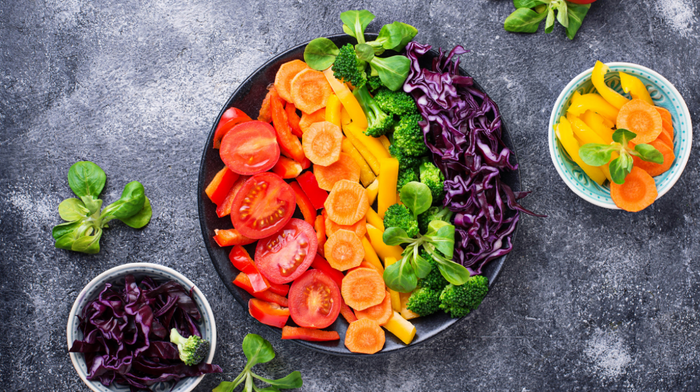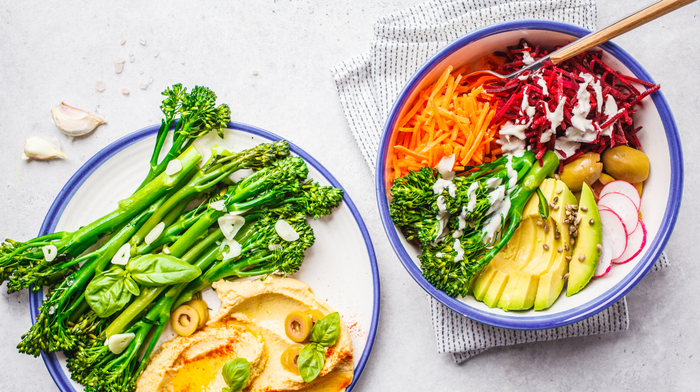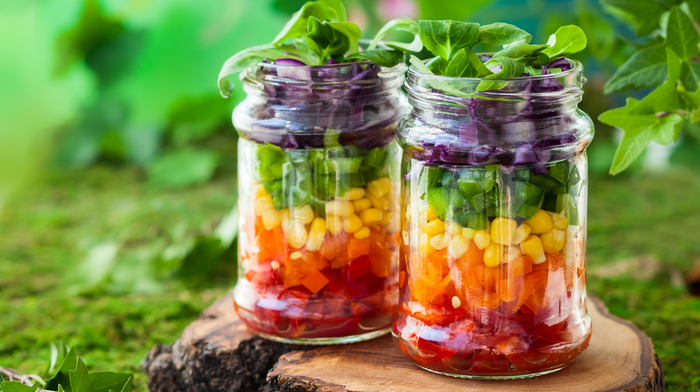
VARIETY IS THE VERY SPICE OF LIFE THAT GIVES IT ALL ITS FLAVOUR!
Even back in 1785, the English poet William Cowper noted that “variety is the very spice of life that gives it all its flavour.” Increasingly, research is showing the importance of dietary diversity in promoting many different aspects of health.
Despite this, of the 250,000 – 300,000 known edible plant species, only 150 to 200 are consumed by humans, [1] and the average western diet utilises only a tiny fraction of these. In fact, today, 75% of the world’s food is generated from only 12 plants and five animal species! [1]
Aiming to ‘eat a rainbow’ of fruit and vegetables every day provides an accessible way to help encourage variety in your diet, and is a fun challenge to set yourself and your family.
Eating a rainbow is particularly beneficial as the different colour pigments in fruits are an indication of some of the different phytonutrients they contain.

For example:
purple/blue fruit and vegetables contain anthocyanidins
orange and yellow varieties contain carotenoids such as beta-carotene
red ones are high in lycopene
white varieties, such as garlic and onions, often contain allicin
greens are high in folate, indoles and saponins.
To help you meet your targets, why not download our ‘Eat a Rainbow Challenge’ handout, and read-on to find out more about some of the health benefits associated with dietary diversity.
COGNITION AND MOOD
There's a growing interest by researchers in the relationship between the diversity of people's diets and their cognition and mental health.
For example, one study analysed psychological resilience (encompassing personal tenacity, optimism, coping with negative mood, secure relationship, and self-control) in 8571 elderly individuals.[2]

They found that poor dietary diversity was associated with a low psychological resilience. The greatest contribution to dietary diversity was from a high consumption of vegetables, fruits,andnuts, suggesting that eating a diet rich in these foods might help promote psychological resilience.
A number of other studies have also found a positive correlation between increased dietary diversity and benefits for mood andcognition.[3][4] This may be because many plant foods are natural sources of neurotransmitters that may influence the nervous system.
CARDIOVASCULAR HEALTH
A number of studies have found that having higher dietary diversity is associated with reduced cardiovascularand metabolic disease risk factors.[5][6]
This is perhaps unsurprising as fibre plays a key role in helping to remove cholesterol from the body via regular bowel movements. It also helps to support healthy blood glucose levels.
Leafy green andcruciferous vegetables have been shown to be particularly beneficial for cardiovascular health.[7]
WEIGHT MANAGEMENT
Plant foodstend to be low energy-density (i.e. they contain fewer calories per gram). This is largely due to the amount of fibre they contain.
This means that in comparison to higher energy density foods (such as cakes, biscuits, burgers and pizza), we can eat a far greater volume for the same number of calories, helping us to feel full for longer.
Perhaps unsurprisingly then, dietary diversity is associated with lower body mass index (BMI) in studies.[8] Offering a variety of vegetables, rather than just one type, has also been shown to increase vegetable consumption and reduce intake of unhealthy energy-dense foods in school children.[9]
FALLS AND FRACTURE RISK
Consuming a higher diversity of vegetables may also potentially reduce the risk of falls and fractures in elderly populations.
A recent 2018 study examined the relationship between vegetable diversity and falls and fractures in Australian women aged 70+ years.

The researchers found that for each additional vegetable consumed, there was an 8% reduction in the risk of falls and a 9% reduction in the risk of fractures.[10]
HEALTHY LONGEVITY
Dietary diversity also appears to increase longevity and the number of years lived in good health (‘healthy life-expectancy’). A recent 2019 study reviewing international data found that after controlling for socioeconomic factors, longer healthy life was found to be enjoyed by populations of countries with greater dietary diversity.[11]
THE MICROBIOME
Research indicates that many of the health benefits associated with eating a diet high in a variety of plant-foods may relate to the positive effect that fibre has on themicrobiome (the community of micro-organisms which reside in the digestive tract).

Much like humans, our gut bacteria have different tastes and preferences for what kinds of fibre they like to eat.
The British and American Gut Projects analysed over 15,000 stool samples from citizens from all walks of life. One of their key findings was that those who ate a higher diversity of plant foods, in particular, over 30 different types of plant foods a week, had significantly more diversity in their microbiome.[12]
WHAT SHOULD I BE EATING?
How many portions of fruit and vegetables we should be eating a day is a topic of debate. Whilst we are all familiar with the traditional government recommendation of 5 portions a day, recent research indicates that consuming higher amounts may have major benefits for health.
Researchers at Imperial College London reviewed all available research in populations worldwide and found that although the recommended five portions of fruit and vegetables a day reduced disease risk, the greatest benefit came from eating 800g a day, which is roughly equivalent to ten portions (with one portion of fruit or vegetables being defined as 80g).[13]
However, fitting in 10 portions a day without feeling like a walking composter is tricky for many, so aiming for 2 portions of fruit and 5 portions of veg a day may be a more realistic target, and is still associated with many benefits.

Eating a greater variety is likely to be easier in the spring, summer and autumn, when many vegetables and fruits are in abundance in the UK. In the winter, your variety may be naturally more limited.
So go on, set yourself a ‘Eat a Rainbow Challenge’ and see how you get on!
1 What is Agrobiodiversity? http://www.fao.org/3/y5609e/y5609e02.htm (accessed April 18, 2019).
2 Yin Z, Brasher M, Kraus V, Lv Y, Shi X, Zeng Y. Dietary Diversity Was Positively Associated with Psychological Resilience among Elders: A Population-Based Study. Nutrients 2019; 11: 650.
3 Poorrezaeian M, Siassi F, Milajerdi A, et al. Depression is related to dietary diversity score in women: a cross-sectional study from a developing country. Ann Gen Psychiatry 2017; 16: 39.
4 Yin Z, Fei Z, Qiu C, et al. Dietary diversity and cognitive function among elderly people: A population-based study. J Nutr Health Aging 2017; 21: 1089–94.
5 Azadbakht L, Mirmiran P, Esmaillzadeh A, Azizi F. Dietary diversity score and cardiovascular risk factors in Tehranian adults. Public Health Nutr 2006; 9: 728–36.
6 Farhangi MA, Jahangiry L. Dietary diversity score is associated with cardiovascular risk factors and serum adiponectin concentrations in patients with metabolic syndrome. BMC Cardiovasc Disord 2018; 18: 68.
7 Blekkenhorst L, Sim M, Bondonno C, et al. Cardiovascular Health Benefits of Specific Vegetable Types: A Narrative Review. Nutrients 2018; 10: 595.
8 Kornatowski BM, Comstock SS. Dietary diversity is inversely correlated with pre-pregnancy body mass index among women in a Michigan pregnancy cohort. PeerJ 2018; 6: e5526.
9 Carstairs S, Caton S, Blundell-Birtill P, Rolls B, Hetherington M, Cecil J. Can Reduced Intake Associated with Downsizing a High Energy Dense Meal Item be Offset by Increased Vegetable Variety in 3–5-year-old Children? Nutrients 2018; 10: 1879.
10 Sim M, Blekkenhorst L, Lewis J, et al. Vegetable Diversity, Injurious Falls, and Fracture Risk in Older Women: A Prospective Cohort Study. Nutrients 2018; 10: 1081.
11 Miyamoto K, Kawase F, Imai T, Sezaki A, Shimokata H. Dietary diversity and healthy life expectancy—an international comparative study. Eur J Clin Nutr 2019; 73: 395–400.
12 McDonald D, Hyde E, Debelius JW, et al. American Gut: an Open Platform for Citizen Science Microbiome Research. mSystems 2018; 3. DOI:10.1128/mSystems.00031-18.
13 Eating more fruits and vegetables may prevent millions of premature deaths | Imperial News | Imperial College London. https://www.imperial.ac.uk/news/177778/eating-more-fruits-vegetables-prevent-millions/ (accessed April 24, 2019).

Related Articles








